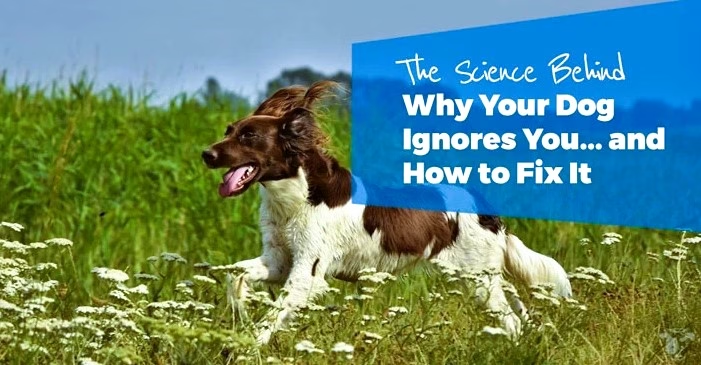Why Your Dog Ignore You: Top Reasons and How to Fix It
Introduction
It can be frustrating and even a little hurtful when your dog seems to ignore you. Whether you’re calling their name, giving a command, or simply trying to get their attention, a lack of response can leave you wondering what went wrong. Dogs are highly social animals, and when they choose not to engage, there’s usually a reason behind it. Sometimes it’s as simple as confusion, boredom, or distraction — other times, it could be a sign of a deeper behavioral or medical issue. Understanding why your dog ignores you is the first step toward improving your communication and strengthening your bond.
In this guide, we’ll explore the most common reasons dogs ignore their owners and provide practical tips on how to fix the issue. With the right approach and a little patience, you can rebuild trust and get your dog’s attention back — in a healthy and lasting way.
Understanding the Bond Between Dogs and Humans

Dogs are naturally social creatures that thrive on interaction with their human companions. Over time, a strong bond forms through consistent care, communication, and positive experiences. However, this bond can weaken if trust or clarity is lost. Understanding how dogs interpret our actions, tone, and body language is key to maintaining that connection. When a dog begins to ignore its owner, it’s often a signal that something in that bond has shifted — and needs attention.
Lack of Proper Training
Training is essential for any dog ignore to understand expectations and respond appropriately to commands. Without consistent training, dogs may become confused or simply fail to learn what certain words or signals mean. This doesn’t mean they’re being stubborn — they may genuinely not understand what you’re asking. Starting with basic commands like “sit,” “stay,” and “come,” and using repetition and rewards, can greatly improve communication and ensure your dog pays attention when it matters most.
Inconsistent Commands or Signals
Dogs rely heavily on routine and consistency. If you use different words, gestures, or tones for the same command, your dog ignore may become confused and start to ignore you. For example, saying “come here” one day and “get over here” the next may sound completely different to your dog. Consistency in cues helps dogs associate specific actions with specific responses. Ensuring everyone in the household uses the same commands also strengthens your dog’s ability to understand and follow through.
Distractions in the Environment
Dogs are easily distracted by sights, sounds, and smells, especially in stimulating environments like parks or busy streets. If your dog ignore seems to ignore you outdoors but listens well at home, environmental distractions may be the cause. Other animals, unfamiliar people, or loud noises can shift your dog’s focus away from you. Training in low-distraction settings first, then gradually increasing the difficulty, helps your dog learn to stay attentive even when there’s more going on around them.
Boredom or Lack of Mental Stimulation
Just like humans, dogs need both physical exercise and mental engagement to stay happy and responsive. A bored dog may seem distant or uninterested in following commands simply because they’re under-stimulated. Without enough playtime, problem-solving, or new experiences, your dog ignore may check out and ignore you altogether. Incorporating interactive toys, puzzle feeders, and new walking routes can re-engage your dog’s mind and help restore their focus and responsiveness during your interactions.
Fear or Anxiety Issues

Fear and anxiety can greatly affect how a dog responds to its owner. If your dog has had negative experiences, sudden changes, or is naturally anxious, they may withdraw or ignore you as a coping mechanism. Yelling, harsh corrections, or chaotic environments can worsen this behavior. Signs like cowering, tail-tucking, or avoiding eye contact may indicate fear rather than defiance. Addressing the root of their anxiety with gentle training and a calm, secure environment can encourage your dog ignore to reconnect.
Medical or Hearing Problems
If your dog ignore suddenly starts ignoring you, it could be due to an underlying medical issue. Hearing loss, especially in older dogs, can make it seem like they’re being unresponsive when they simply can’t hear you. Other health conditions such as pain, infections, or neurological issues can also affect their behavior. It’s important to observe any additional changes, like lethargy or disinterest in usual activities. A visit to the veterinarian can help rule out or address any medical concerns.
Reinforcing Bad Behavior Unintentionally
Sometimes, dog owners accidentally reinforce the very behavior they’re trying to stop. For example, if your dog ignores you and still gets treats, playtime, or attention, they learn that not listening is acceptable. Even negative attention, like yelling, can reinforce unwanted behavior if the dog ignore sees it as interaction. The key is to consistently reward positive behavior and ignore or redirect negative actions. Being mindful of your responses helps set clear expectations and encourages better communication with your dog.
Changes in Routine or Household
Dogs thrive on routine and feel more secure when their daily schedule is predictable. Changes such as a new family member, a move to a new home, or altered feeding and walking times can cause stress or confusion. As a result, your dog may appear distant or ignore you. It’s important to re-establish consistency and provide extra reassurance during these transitions. Sticking to regular routines and spending quality time together can help your dog adjust and regain their focus on you.
Reinforce Basic Obedience Commands
Going back to the basics is one of the most effective ways to improve your dog’s responsiveness. Practicing simple commands like “sit,” “stay,” and “come” in a distraction-free environment helps rebuild focus and trust. Keep training sessions short, consistent, and fun to avoid frustration. Use treats or praise to reinforce positive behavior, and always be patient. Once your dog is reliably responding at home, you can gradually introduce more distractions to strengthen their attention and obedience in different settings.
Use Positive Reinforcement Consistently
Positive reinforcement is a powerful tool in dog training. Rewarding your dog immediately when they respond correctly encourages them to repeat the behavior. This could be in the form of treats, toys, praise, or petting—whatever motivates your dog most. Avoid punishment, as it can damage your relationship and create fear or confusion. Instead, focus on catching your dog doing the right thing and reinforcing it consistently. Over time, this approach helps your dog stay engaged and eager to listen.
Eliminate Distractions During Training
If your dog is struggling to focus during training sessions, the environment may be too distracting. Start training in a quiet, familiar space where your dog feels safe and can concentrate. Gradually increase the level of distraction as your dog becomes more confident with commands. For example, move from your living room to your backyard, then to a quiet park. Controlling distractions while training ensures your dog understands what’s expected before being challenged in more stimulating environments.
Increase Mental and Physical Stimulation
A tired dog is often a more attentive dog. Providing regular physical exercise—like walks, play sessions, or agility activities—helps burn off excess energy that might otherwise lead to disobedience or distraction. Equally important is mental stimulation, which keeps your dog engaged and sharp. Use puzzle toys, scent games, or teach new tricks to challenge their mind. By meeting both their physical and mental needs, you’ll likely notice your dog becoming more responsive and eager to interact.
Stay Calm and Patient While Communicating

Your energy and tone greatly influence how your dog responds to you. Yelling, frustration, or erratic behavior can confuse or scare your dog, causing them to shut down or ignore you. Instead, maintain a calm, steady voice and consistent body language when giving commands. Dogs respond best when they feel safe and understand what’s expected of them. Patience is key—building strong communication takes time, especially if trust has been broken or training has been inconsistent.
Rule Out Health Issues with a Vet Check
Before assuming behavioral issues are to blame, it’s important to rule out any medical conditions that might be affecting your dog’s responsiveness. Hearing loss, vision problems, pain, or underlying illness can all lead to changes in behavior. If your dog suddenly starts ignoring commands or seems less engaged, schedule a check-up with your veterinarian. Catching and addressing health issues early not only improves your dog’s well-being but also ensures that your training and communication efforts are effective.
When to Seek Professional Help
If yourdog ignoreTop 10 Strongest Dog Breeds continues to ignore you despite consistent training, patience, and effort, it may be time to consult a professional. Certified dog ignore trainers or animal behaviorists can identify underlying issues you might not notice and create a personalized training plan. This is especially important if fear, aggression, or trauma is involved. Professional guidance can accelerate progress, prevent frustration, and help rebuild a healthy bond between you and yourdog ignore in a safe, structured way.
Conclusion
Being ignored by your dog can be discouraging, but it’s rarely a sign of defiance. More often, it reflects confusion, lack of training, or unmet needs. By understanding the root causes and applying thoughtful solutions—like consistent training, positive reinforcement, and meeting your dog’s physical and emotional needs—you can improve communication and strengthen your bond. Stay patient, observant, and proactive. With time and effort, your dog ignore will be more attentive, responsive, and eager to engage with you once again.
You Can Also Read: Skin Allergy Medicine for Dogs
FAQS
What does it mean when my dog ignores me?
There are several reasons why your dog might ignore you. It could be due to distractions, health issues, lack of training, or even a sign of independence. Understanding your dog’s behavior and addressing any underlying issues can help improve the bond between you and your furry friend.
Why do dogs ignore humans?
Causes vary from changes in their living situation, the loss of an animal or human companion, to trauma. Dogs with depression often exhibit low energy, withdrawal, and changes in sleep and appetite. Anxiety, too, makes them appear distant, as they are too caught up in their internal stressors to interact as usual.
Do dogs get sad when ignored?
Dogs are incredibly social animals, and they love attention and connection. If they’re left alone for long periods, don’t get enough quality time with you, or feel ignored, it can take an emotional toll. A lonely dog might act clingy when you’re around or, conversely, seem withdrawn and distant.
Is it normal for dogs to ignore you?
Unfortunately, in some scenarios dogs ignore their people because they’ve learned that interacting can be unpredictable or scary. Whether from past abuse, neglect, or because a dog is naturally more introverted, some pups have decided that it’s best to keep to themselves.
Why is my dog rejecting me?
Fear is one of the most common reasons behind unusual or “unfriendly” dog behavior. Changes in the environment, loud noises, unfamiliar people, or even past trauma can trigger anxiety. Your dog isn’t avoiding you or growling out of hate—they’re scared and trying to protect themselves.
